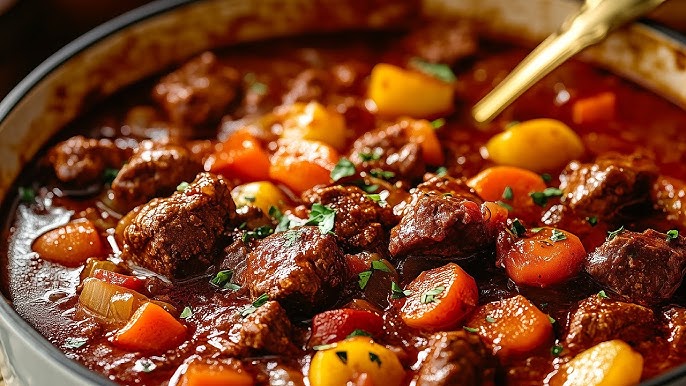Traditional Goulash Recipe: Let’s start at the very beginning—Hungary, where this iconic stew was born. Goulash, or “gulyás” in Hungarian, dates back to the 9th century when herdsmen would slow-cook meat in heavy iron cauldrons over open fires. The name itself is derived from “gulyás,” meaning herdsman, reflecting its rural roots. Over time, this humble dish evolved into a national treasure and spread across Central Europe, adapting slightly in flavor and preparation wherever it landed. What remained consistent, though, is its rich, hearty character and unmistakable paprika punch.
Goulash isn’t just food—it’s history served in a bowl. It’s one of those dishes that tell a story with every bite. You’re not just tasting beef and spices; you’re getting a taste of generations, of traditions passed from grandmothers to grandchildren.
Why Goulash Is a Beloved Comfort Food
Imagine a cold winter evening, snow gently falling outside, and you’re curled up with a steaming bowl of goulash. Sounds perfect, right? That’s the magic of this dish. It’s warm, comforting, and deeply satisfying. The thick, stew-like consistency combined with tender meat and aromatic spices makes it ideal for cozy nights or feeding a hungry crowd.
What makes goulash stand out among other stews is its unique spice blend—especially Hungarian paprika, which brings a smoky, slightly sweet, and peppery depth to the dish. Add in slow-simmered onions, garlic, and bell peppers, and you’ve got a dish that wraps you in a blanket of flavor.
Essential Ingredients for Traditional Goulash
Meat Selection and Preparation
Authentic goulash calls for beef—specifically chuck or shank. These cuts are rich in connective tissue and fat, making them perfect for slow cooking. As the meat simmers, it becomes melt-in-your-mouth tender, enriching the broth with flavor.
Before cooking, cut the beef into medium-sized cubes. Don’t trim all the fat—some of it is essential for a rich and silky stew. Pat the pieces dry with a paper towel; this helps them sear properly and locks in flavor.
Spices That Define the Dish
Paprika is the star of the spice cabinet when it comes to goulash. But not just any paprika—Hungarian sweet paprika is key. It adds color and warmth without overpowering heat. Some recipes add a touch of hot paprika or cayenne for a little kick, but that’s up to your taste.
Other essentials include:
- Caraway seeds – for a subtle licorice-like flavor
- Garlic – lots of it, minced or sliced
- Bay leaves – to deepen the aroma
- Marjoram – optional, but it enhances the rustic feel
Salt and black pepper bring it all together. Trust me, you don’t want to skip or substitute any of these—they each play a crucial role.
Vegetables and Broth Base
Onions are a must and not just a few—goulash requires a lot of them. They cook down and practically dissolve into the stew, creating a sweet, flavorful base. Red or yellow onions work best.
Bell peppers add a hint of sweetness and color. Potatoes are often included too—they help thicken the stew naturally and make it even more filling.
For the liquid, go with beef broth or stock. Some folks like to add a splash of tomato paste or crushed tomatoes for extra depth, while others stick to the clear, paprika-rich broth. Either way, the result is deeply savory and soul-warming.
Equipment You’ll Need
Best Pot for Goulash
A good-quality Dutch oven or heavy-bottomed pot is ideal for goulash. Why? Because it holds heat evenly and allows for long, slow cooking without burning. A cast iron pot with a lid is perfect—it mimics those old-school cauldrons Hungarian cowboys once used.
Size matters too. You’ll want at least a 5-6 quart pot if you’re making enough for a family or leftovers (and trust me, you’ll want leftovers).
Tools That Make Cooking Easier
Besides the pot, here are a few other helpful tools:
- A sturdy wooden spoon (for stirring without scratching your pot)
- A sharp chef’s knife (for prepping meat and veggies)
- A ladle (for serving)
- Cutting board (you’ll be chopping a lot)
- Measuring spoons (for those paprika-perfect proportions)
Having the right tools doesn’t just make cooking easier—it makes it more enjoyable. When everything flows smoothly, you can focus on flavor and fun.
Step-by-Step Guide to Making Traditional Goulash
Step 1: Preparing the Ingredients
Before you heat anything, prep everything. Dice your onions and bell peppers, cube the beef, mince the garlic, and measure out your spices. Having everything ready makes the cooking process smoother and less stressful.
This is also a good time to warm your beef broth and mix in any tomato paste if you’re using it. The idea is to have everything lined up and ready to go once you start cooking.
Step 2: Searing the Meat
Heat a bit of oil in your Dutch oven over medium-high heat. Working in batches, sear the beef cubes until they’re brown on all sides. Don’t overcrowd the pot, or the meat will steam instead of brown. Set the seared meat aside on a plate.
This step builds the base flavor of your goulash. The caramelized bits left behind—called fond—are pure gold when deglazed with broth.
Step 3: Cooking the Vegetables
Once all the meat is seared and set aside, it’s time to build your flavor base with vegetables. In the same pot, add a bit more oil if needed and toss in your chopped onions. Cook them slowly over medium heat until they’re soft and golden brown—this may take up to 15 minutes, but it’s totally worth the time. Stir often and don’t rush it. The onions should practically melt into the pot, giving your goulash that deep, sweet flavor.
Next, add the minced garlic and bell peppers. Stir everything together and let it cook for another 5 minutes until fragrant. The peppers will soften, and the garlic will start releasing that mouthwatering aroma. This is the moment when your kitchen starts to smell like magic.
Now sprinkle in your paprika. This is a key moment—remove the pot from the heat for a second before adding the paprika to avoid burning it, which can make it bitter. Stir well so the paprika coats the veggies and blends in fully. Return the pot to the heat once it’s mixed in.
Step 4: Simmering for Flavor
Now it’s time to bring it all together. Return the seared beef to the pot and stir everything until well combined. Add in your beef broth (and tomato paste if using), making sure the liquid just covers the meat and vegetables.
Throw in the bay leaves, caraway seeds, salt, pepper, and marjoram if you’re using it. Give it a good stir, bring it to a simmer, then cover the pot with a lid and reduce the heat to low.
Let it simmer gently for 1.5 to 2 hours. Yes, it’s a bit of a wait—but this is where the magic happens. The beef turns tender, the broth thickens, and the flavors meld together into one incredible pot of deliciousness.
Stir occasionally and check the liquid level. If it reduces too much, add a splash of hot water or more broth. The goal is a thick, hearty stew—not soup, but not dry either.
Step 5: Final Touches and Serving Tips
When your beef is fork-tender and the stew is rich and flavorful, it’s time for final touches. Taste and adjust the seasoning—maybe a pinch more salt or a sprinkle of paprika if you like it bold.
Some traditional versions of goulash include a handful of diced potatoes during the last 30 minutes of cooking. They soak up the flavor and add more body to the dish. If you skipped potatoes, you could always serve the goulash over a starch like egg noodles, spaetzle, rice, or mashed potatoes.
Top each bowl with a dollop of sour cream and a sprinkle of fresh parsley. Serve it with crusty bread for mopping up every last drop. And that’s it—you’ve just made a traditional Hungarian goulash from scratch!
Tips for the Best Goulash
Mistakes to Avoid
Even a dish as rustic as goulash can go wrong if you’re not careful. Here are some common mistakes and how to avoid them:
- Using lean meat – Avoid cuts like sirloin or tenderloin. They dry out. Use chuck or shank for juicy, flavorful beef.
- Skipping the paprika step – Always add paprika off the heat to prevent it from burning.
- Not caramelizing the onions – They’re the foundation of your flavor. Don’t rush them!
- Overcrowding the pot when browning meat – Brown in batches for a nice sear and better taste.
- Too much liquid – Goulash should be thick and hearty. Don’t drown it in broth.
Enhancements for Extra Flavor
Want to take your goulash to the next level? Here are a few enhancements you can try:
- Red wine splash – Add a half cup of dry red wine after sautéing the veggies. Let it reduce before adding broth.
- Smoked paprika – Mix in a bit with sweet paprika for deeper flavor.
- Root vegetables – Add parsnips or carrots for earthy sweetness.
- Chili flakes or hot paprika – For a spicy kick.
- A touch of vinegar or lemon juice at the end – Brightens the dish and balances richness.
These tweaks are optional but can make your goulash feel extra gourmet while still staying true to its roots.
FAQs about Traditional Goulash Recipe
What is traditional goulash?
Traditional goulash is a hearty stew known for its rich flavors and deep roots in Hungarian cuisine. It typically features chunks of beef, onions, red bell peppers, and a generous amount of paprika, simmered slowly to perfection. This dish is not only a staple in Hungary but has also become popular across Central Europe.
What kind of meat is best for goulash?
For an authentic goulash, opt for cuts of beef that are well-suited for slow cooking. Chuck roast, shoulder, or shank are excellent choices as they become tender and flavorful when cooked at low temperatures for an extended period. These cuts also absorb the spices well, enhancing the overall taste of the goulash.
Can I make goulash in a slow cooker?
Absolutely! A slow cooker is ideal for making goulash, as the low and slow cooking method allows the flavors to meld beautifully and the meat to become fork-tender. Simply brown your meat and onions before adding them to the slow cooker with the other ingredients, and let it work its magic for several hours.
What are the key spices in traditional goulash?
Paprika is the star spice in traditional goulash, giving the dish its distinctive color and flavor. Use sweet Hungarian paprika for an authentic taste. Other spices can include caraway seeds and black pepper, which provide additional depth and warmth to the dish.
What do you serve with goulash?
Goulash is often served with egg noodles or dumplings, such as spaetzle, to soak up the savory sauce. For a lighter option, you can pair it with a slice of crusty bread or a simple side salad. This makes for a comforting, filling meal that’s perfect for any season.
Is goulash gluten-free?
Goulash can easily be made gluten-free by ensuring that all added ingredients, such as broth or spices, are free of gluten. Additionally, serve it with gluten-free sides like rice or gluten-free pasta to accommodate those with dietary restrictions.
How long can you store leftover goulash?
Leftover goulash can be stored in an airtight container in the refrigerator for up to 3-4 days. The flavors often improve with time, making the leftovers even more delicious. You can also freeze goulash for up to 3 months, thawing and reheating it slowly for a quick and tasty meal later on.
Conclusion
Traditional goulash is more than just a stew—it’s a heartwarming tribute to simple, rustic cooking. With just a few humble ingredients and a bit of patience, you can recreate a dish that’s been loved across Europe for centuries. It’s rich, it’s comforting, and it’s deeply satisfying.
Whether you’re cooking for your family on a chilly night or impressing guests with a taste of Hungary, this dish never fails. So grab your pot, a hearty cut of beef, and some good-quality paprika, and get simmering. You’re in for something special.



